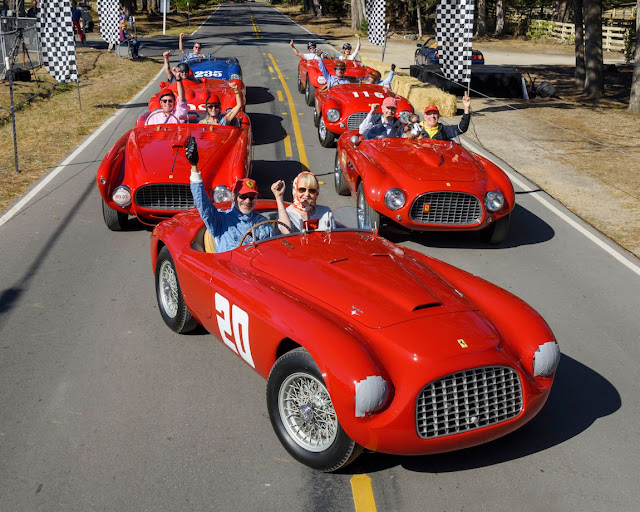The 10 Most Beautiful Ferraris
1949 Ferrari 166 MM Touring Barchetta
 |
| 1949 Ferrari 166 MM Touring Barchetta |
Specs
The 166 MM is one of the earliest Ferraris to ever grace the earth, and it’s also one of the rarest. The MM stands for the famous Mille Miglia race, and the Barchetta name stands for “little boat”, which is an open-top design for two-seat Ferraris. A scant 25 versions of Barchetta were made, which means even if you’re loaded, you’re not an automatic shoe-in as an owner. Design-wise, this is the iconic early-generation Ferrari. The 166 MM’s large eggcrate grille leads to a long raised hood, punctuated by a beautifully executed small vent. Flanking the striking fascia are two of the longest, sexiest front fenders the world has ever seen. And though the 166 MM is powered by a 160 horsepower V12, it maintains a high degree of performance thanks to its structural rigidity and light weight. It even took first place at its racing debut at the 1950 Mar del Plata in Argentina. Racing pedigree is imperative for vintage Ferraris — but the 166 MM’s stunning simplicity alone gets it onto this list.
1962 Ferrari 250 GTO


Specs
- Year: 1948
- Type: 2-seat spider
- Engine: V12
- Transmission: 5-speed manual
- Horsepower: 140
- Top Speed: 136 mph
1962 Ferrari 250 GTO
Specs
- Year: 1962
- Type: 2-seat berlinetta
- Engine: V12
- Transmission: 5-speed manual
- Horsepower: 300
- 0-60: 6.1 seconds
- Top Speed: 174 mph
1957 Ferrari 250 Testa Rossa
Specs
- Year: 1957
- Type: 2-seat spider
- Engine: V12
- Transmission: 5-speed manual
- Horsepower: 300
- 0-60: 6 seconds
- Top Speed: 167 mph
250 GT California Spyder LWB
Specs
Year: 1958
Type: 2-seat spider
Engine: V12
Transmission: 5-speed manual
Horsepower: 228
0-60: 4.5 seconds
Top Speed: 145 mph
If there’s a Ferrari Spyder to covet, it’s this one. The California name simply means Ferrari created it for wealthy Americans to drive and flaunt. Scaglietti designed the California Spyder as a convertible interpretation of the iconic 250 GT, and he kept it light with aluminum in the hood, doors and the trunk. The long wheelbase design and long hood give it supreme elegance, especially with the top down — and the fact that only 50 were made make it a true collector’s prize.
1968 Ferrari 365 “Daytona” GTB/4
Specs
- Year: 1968
- Type: 2-seat berlinetta or spider
- Engine: V12
- Transmission: 5-speed manual
- Horsepower: 352
- Top Speed: 174 mph
1984 Ferrari 288 GTO
Specs
- Year: 1984
- Type: 2-seat berlinetta
- Engine: twin turbo V8
- Transmission: 5-speed manual
- Horsepower: 400
- Top Speed: 189 mph
1966 Ferrari 275 GTB/4 Berlinetta
Specs
- Year: 1964
- Type: 2-seat berlinetta
- Engine: V12
- Transmission: 5-speed manual
- Horsepower: 280
- Top Speed: 160 mph
1967 Dino 206 GT
Specs
- Year: 1967
- Type: 2-seat berlinetta
- Engine: V6
- Transmission: 5-speed manual
- Horsepower: 180
- Top Speed: 146 mph
1962 250 GT Lusso Berlinetta
Specs
- Year: 1962
- Type: 2-seat berlinetta
- Engine: V12
- Transmission: 5-speed manual
- Horsepower: 240
- Top Speed: 149 mph
1959 Ferrari 400 Superamerica Coupé Speciale
Specs
- Year: 1959
- Type: 2-seat berlinetta
- Engine: V12
- Transmission: 4-speed manual
- Horsepower: 340
- Top Speed: 174 mph
Ferrari’s first 400 Superamerica looked less like a Ferrari and more like an thick Russian limo. Fiat wanted something different, so Pininfarina premiered this unique three-box Ferrari at the 1959 Salon de Torino in Coupé Speciale, built especially for Fiat boss Gianni Agnelli with a 340 horsepower V12 engine. It was boxy and beautiful in ways other sleeker Ferraris could never match, sporting a tall rectangular grille, chrome headlights and a thin chrome bumper, and a tall greenhouse with a schmaltzy wraparound windshield. Most folks would never recognize it as a true Ferrari — but that’s precisely what makes it so unique.
1976 Ferrari 512 BB
Specs
- Year: 1976
- Type: 2-seat berlinetta
- Engine: V12
- Transmission: 5-speed manual
- Horsepower: 360
- 0-60: 5.5 seconds
- Top Speed: 187 mph
